With the brand new Rival eTAP AXS, SRAM present their third wireless groupset for road and gravel bikes, of which many features have trickled down from the RED and Force range, even upping its game with an all-new power meter and cassette. Does that mean they’ve cut back in other areas? Read on for all the details, including weights and prices.

Almost two years after launching the SRAM RED and Force eTap AXS groupsets, the US brand are at it once more with their third wireless groupset, the new Rival eTap AXS. If the prices of the premium Force and RED groupsets have been out of reach, you’ll be happy to hear about SRAM’s new entry-level wireless groupset, making clean cockpits accessible to a lot more riders. Before going into the groupset’s details, we would like to look at the SRAM AXS system in general.
What’s behind SRAM AXS groupsets and which components do they include?
AXS (pronounced access) represents SRAM’s wireless 12-speed groupsets from the road and mountain bike sectors, successfully declaring war on cables and awkward cable routing. In doing so, the components don’t only communicate with each other. Thanks to BLE and ANT+ connectivity, they can also connect wirelessly with smartphones and GPS bike computers. Together with the SRAM AXS app, available for all iOS and Android devices, this doesn’t only allow you to check the battery status and update the firmware. You can also customise the shifters’ functions to suit individual preferences, in case you’re not happy with the standard SRAM AXS commands – left for downshifting, right for upshifting, both for the front derailleur. Additionally, you can have the gear selection, number of shifts and battery status displayed on your bike computer.

Other convenient features available in the SRAM AXS app include the so-called sequential and compensating modes. In sequential mode, the front SRAM AXS derailleur shifts automatically to prevent crossing your chain. In compensation mode, the rear derailleur automatically shifts up or down when you shift into the bigger or smaller chainring in an attempt to keep your pedalling cadence consistent. The AXS ecosystem is entirely cross-compatible, including all components from the road and MTB range. For example, you can pair the RockShock Reverb AXS dropper post and a wide-range SRAM Eagle AXS rear derailleur and 10–50 t or even 10–52 t cassette with the standard AXS drop-bar shifters. A gravel bike with a 1×12 drivetrain offering a 520% gear range and a dropper post? No problem!
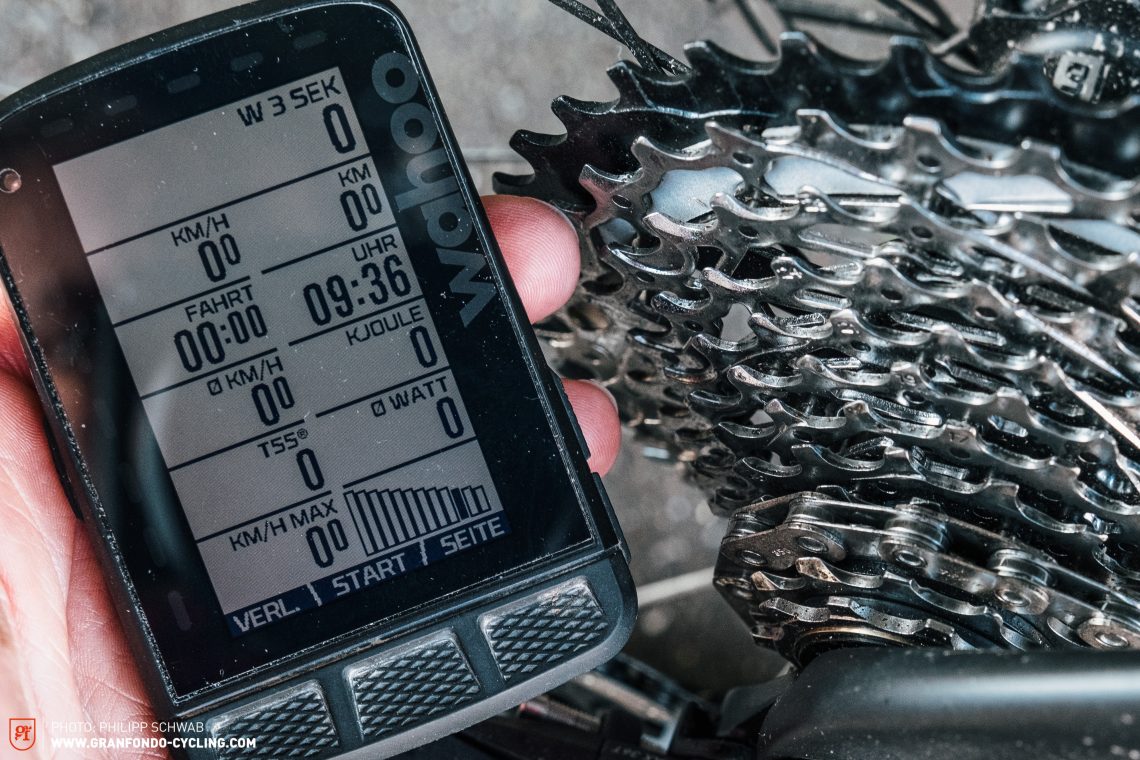
Complimenting the SRAM AXS app, there is a new feature that many die-hard AXS fans have been eagerly awaiting: the AXS web dashboard. If you own a Garmin or Wahoo device and other smart components such as those from SRAM AXS, a power meter or tire pressure sensor, you can upload your riding data to the dashboard and evaluate your shifting, gears used, power zones and tire pressure along with your routes.
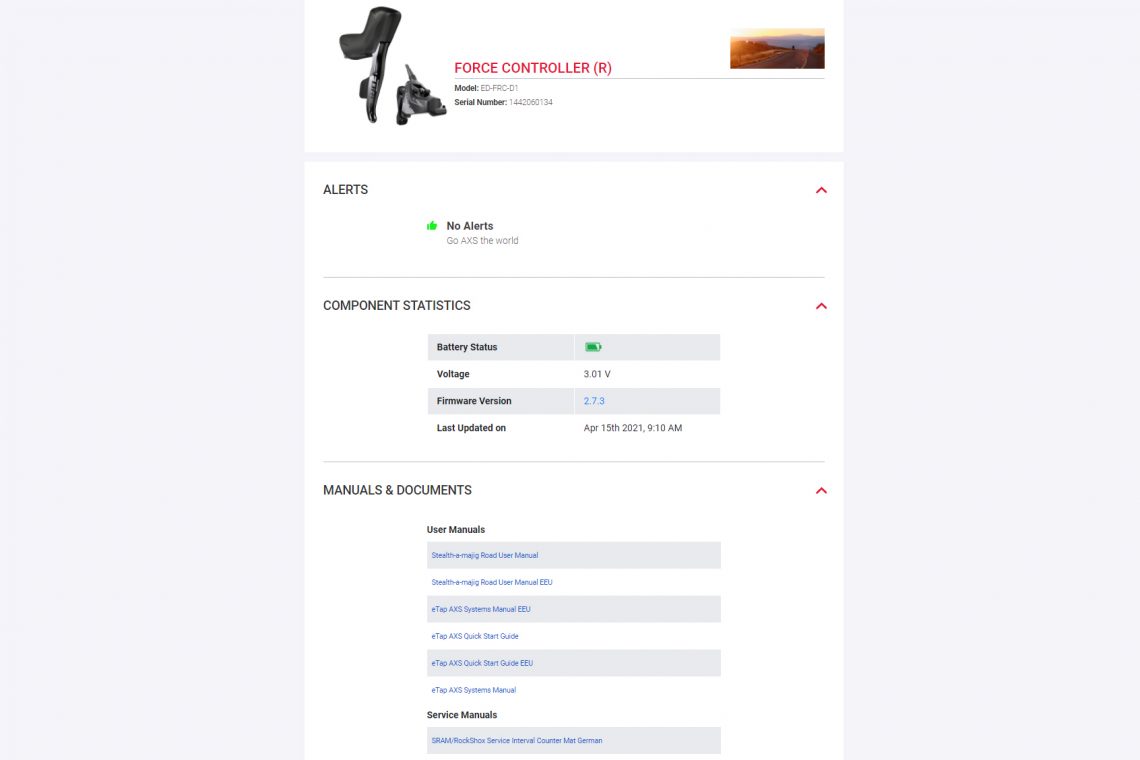
Now that we’ve covered the software aspect of it, what about the AXS hardware? With the introduction of the RED eTap AXS groupset, SRAM also introduced a new bottom bracket standard that most of you should be familiar with by now: DUB. The great thing about DUB is that it’s compatible with numerous existing bottom bracket standards, including BSA, BB30, PF30 and PF86.5. For a good illustration of all standards, including the respective bearing widths and the appropriate number of spacers, click here.
To meet the wide range of requirements that riders of various skill and fitness levels have of their bikes, SRAM accompanied the introduction of 12-speed AXS drivetrains with the so-called X-Range ratio, supposedly accommodating everyone from professionals to hobby and gravel riders. In principle, a portion of the gear range has been shifted from the crankset to the cassette by reducing the difference in chainrings to 13 teeth and increasing the size of the cassette up to 10–36 t. The aim of this was to allow riders to shift chainrings less frequently. Moreover, if you have to shift from one chainring to another, the gear jump is smaller and requires fewer shifts on the cassette to maintain your cadence. X-Range cassettes are based on a smallest sprocket of 10 t, making them compatible with XDR freewheels only. However, since replacing the freewheel can be done within minutes on most hubs, this shouldn’t be a hindrance.
What differentiates SRAM Rival eTap AXS? All SRAM Rival AXS eTap components in detail
In the following section, we take a detailed look at the new SRAM Rival AXS eTap groupset’s components and the features that distinguish them from the existing AXS groupsets.
The SRAM Rival eTap AXS HRD shifters and brakes in detail
Compared to the more expensive Force and RED groupsets – check out our in-depth review of SRAM RED eTap AXS here – the new Rival eTap AXS groupset doesn’t have the Contact Point Adjustment feature, which would allow you to adjust the bite point of the brakes. On the upside, the controls are noticeably slimmer thanks to the lack of the adjustment screw, and the textured shifter paddles and rubber hoods promise to be very comfortable. The lever reach, i.e. the distance between the lever and the handlebar, remains adjustable, accommodating hands of all sizes. Apart from that, the Bleeding Edge system is also reserved for the higher-end Force and RED groupsets – you’ll have to rely on a standard grub screw to bleed the system. However, a lot of the technology and many features of the higher-end groupsets have trickled down to the more affordable Rival eTap AXS range, including the servomotors in the front and rear derailleur. Powering the controls are two CR2032 button cells, one in each, which SRAM claim should last two years with normal use or 15 riding hours per week. In contrast to the mechanical rim brake option offered in the Force and RED range, the Rival eTap AXS groupset is exclusively compatible with hydraulic flat mount disc brakes. If your bike relies on the post mount or IS disc brake mounting standard, you can use the SRAM Level callipers from the mountain bike sector as the only difference between the callipers is the mounting system. The steel, one-piece Paceline brake rotors are available in diameters of 140 and 160 mm, both in a 6-hole or a CENTER LOCK version.

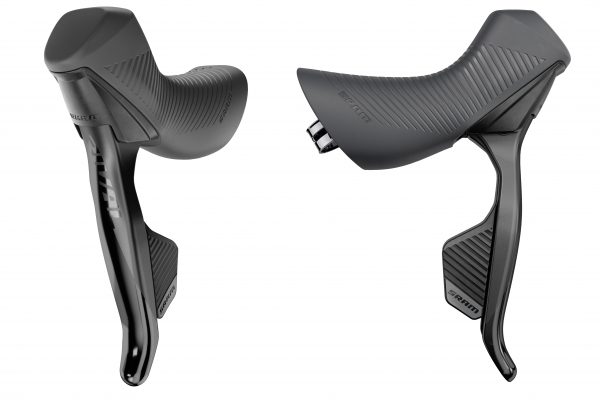
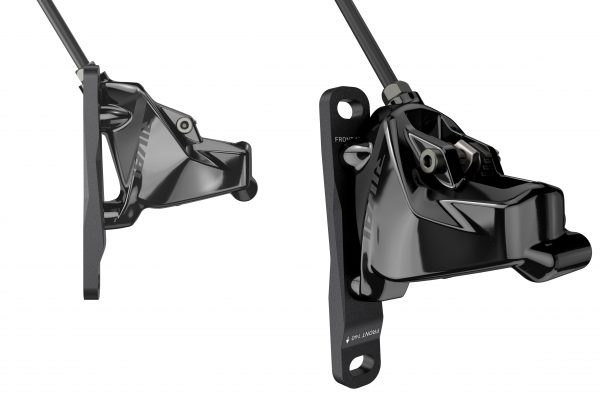
The SRAM Rival eTap AXS crankset and front derailleur in detail
The highlight of the latest AXS groupset is the € 260 Rival AXS power meter. Having taken 17 months to develop, SRAM present an all-new power meter that simply gets inserted into the DUB crankshaft and is claimed to add less than 40 g to your crankset. Great news for those who already own a SRAM AXS groupset: the power meter is cross-compatible with existing Force and RED AXS drivetrains. The power meter is one-sided, measuring input on the left and powered by AAA batteries. According to the manufacturer, a set of batteries should last over 400 hours. In contrast to the Force and Red groupsets, the new SRAM Rival eTap AXS crankset is made of aluminium instead of carbon and dispenses with the detachable spider on its 2x models. The aluminium spider is cast as one piece with the crank arm to cut back on production costs. The available crank lengths are 160, 165, 170, 172.5 and 175 mm.
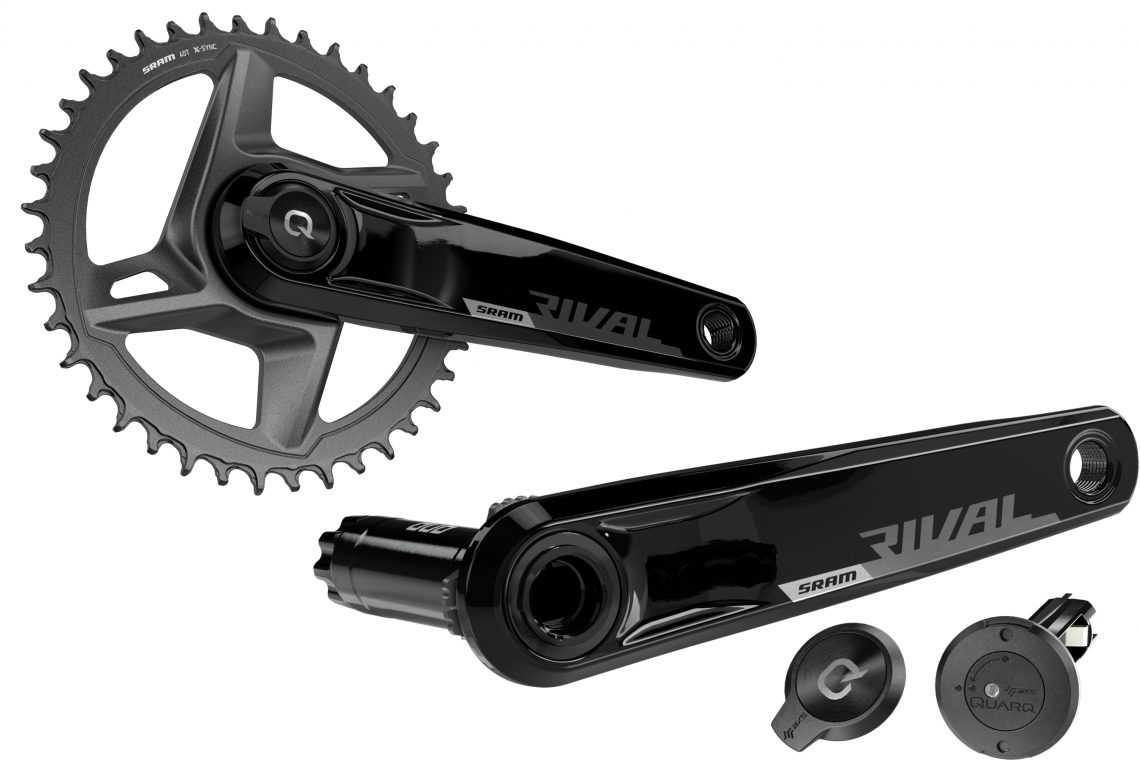
In addition to a Rival crankset with a standard axle width and a chain line of 45 mm/Q-factor of 145.5 mm, available in 46/33 t or 48/35 t 2x configurations, you also get a Rival Wide eTap AXS crankset for bikes with wide tires. With these, the chain is shifted outwards by 2.5 mm, giving you a 47.5 mm chain line and a Q factor of 150.5 mm. As such, you can run tires up to 700 x 45C or 650 x 53B wide without having to worry about the chain rubbing the tire. The Rival Wide crankset is available either as a 43/30 t 2x configuration or a 1x setup with the new direct mount chainring, ranging in sizes from 38 to 46 teeth.
If you choose the Rival AXS Wide crankset, you have to use a Rival eTap AXS Wide front derailleur, as it isn’t compatible with the standard derailleur. The front derailleurs rely on the same battery as the rear derailleur, and SRAM claim that one charge should last about a month or 1,000 km if you ride two hours a day on average. Recharging the battery only takes about 60 minutes.

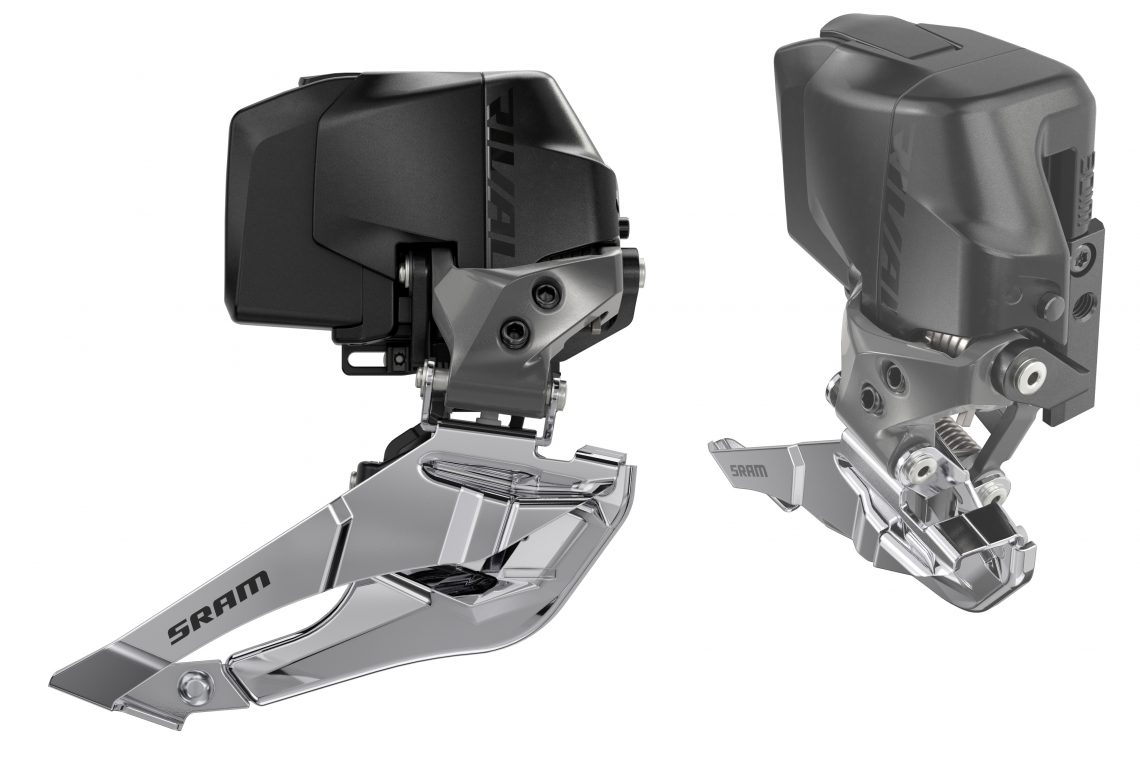
The SRAM Rival eTap AXS cassette and chain in detail
The 10–30 t cassette is a new addition, not available in the Rival groupset until now. You also get a wider range Rival 10–36 t cassette, both of them silver and made of steel. Of course, all cassettes from the Force and RED groupsets in sizes 10–28 and 10–33 are cross-compatible with the SRAM Rival groupset – the small 10–26 t cassette doesn’t work with the rear Rival derailleur. The Sylomer foam damper is new, too, fitted between the largest and second-largest sprocket and intended to keep the drivetrain running quieter. The stealth rubber rings between the smallest sprockets remain unchanged. Same as the flagship groupsets, the new SRAM Rival eTap AXS relies on SRAM’s proprietary chain with Flattop technology and a Flattop PowerLock chain lock. Together with SRAM’s new mountain bike GX Eagle AXS groupset, which we have already put through its paces in our sister magazine ENDURO, we’re sure to see many GX Eagle and Rival AXS mullet builds appear on the gravel scene. By taking the Rival eTap AXS shifters and crankset and combining them with a GX Eagle AXS rear derailleur and 10–52 t cassette, you can have a 1×12 drivetrain offering a 520% gear range on your gravel bike!
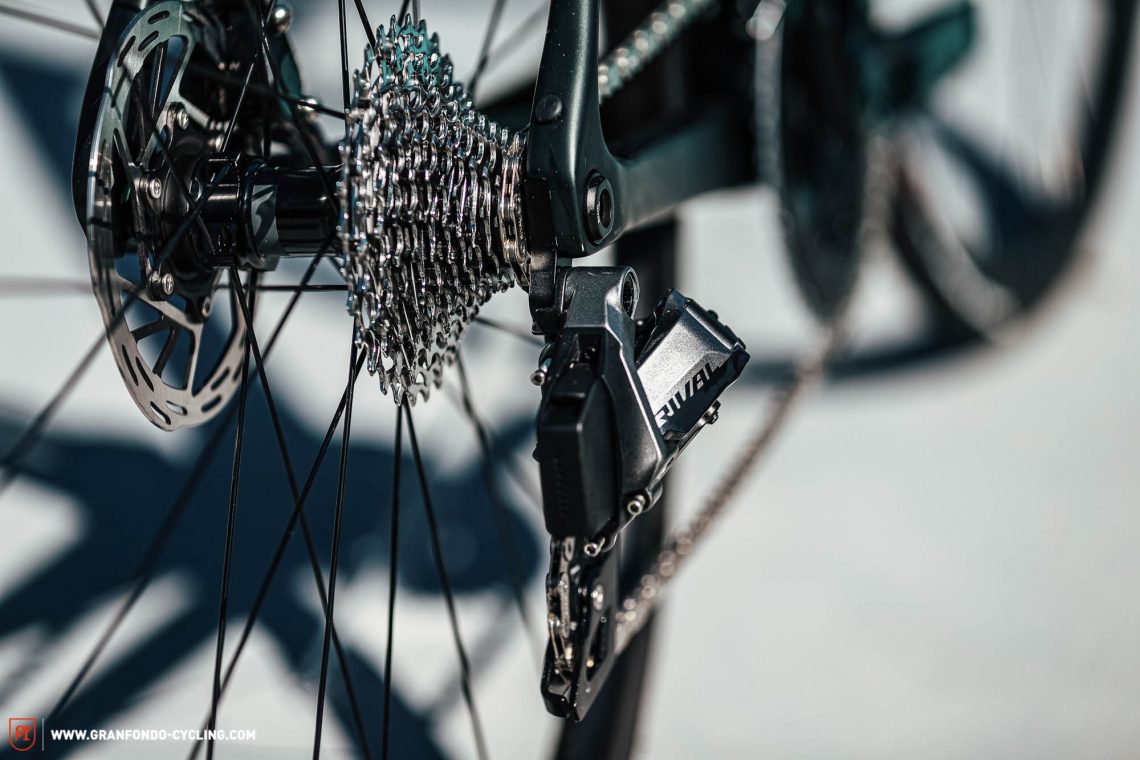
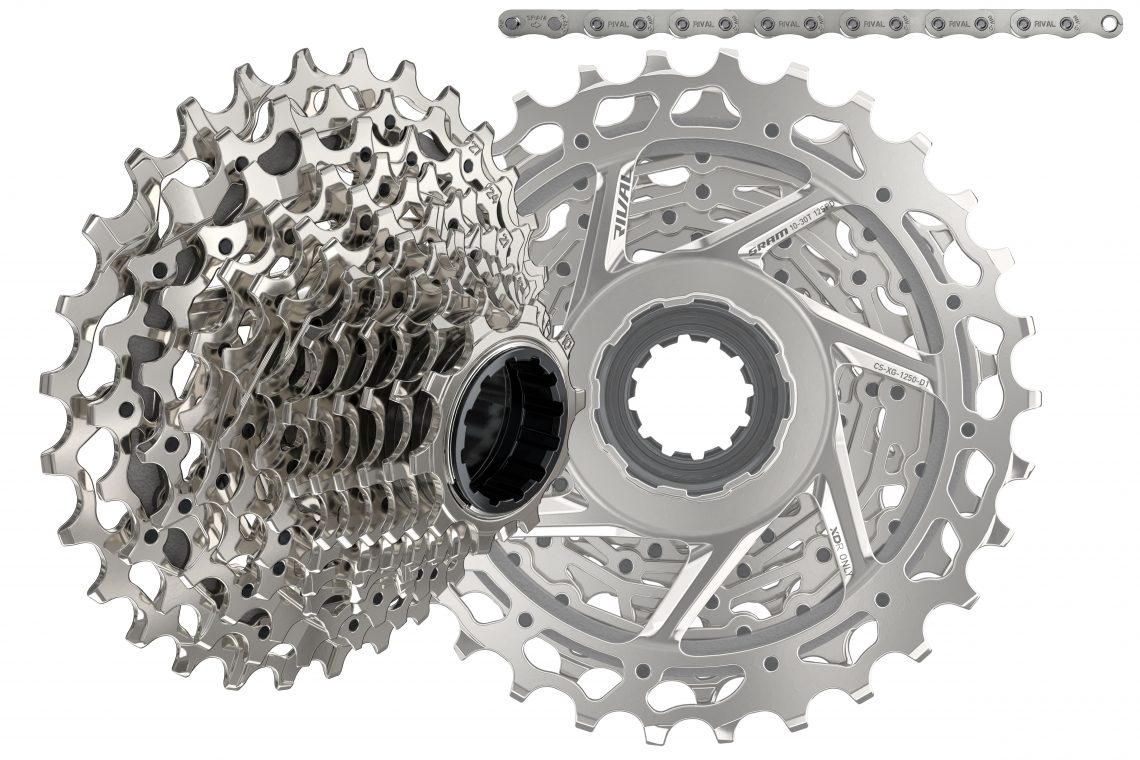
The SRAM Rival eTap AXS rear derailleur in detail
The Rival eTap AXS rear derailleur is equipped with a clutch and compatible with 1 and 2x setups. It works with most cassettes, including 10–28, 10–30, 10–33 and 10–36 tooth versions, though the smallest 10–26 t cassette from the RED groupset isn’t supported. To mount a wide-range Eagle cassette, you’ll need a compatible Eagle AXS rear derailleur as the Rival eTAP AXS rear derailleur supports a maximum sprocket size of 36 t.
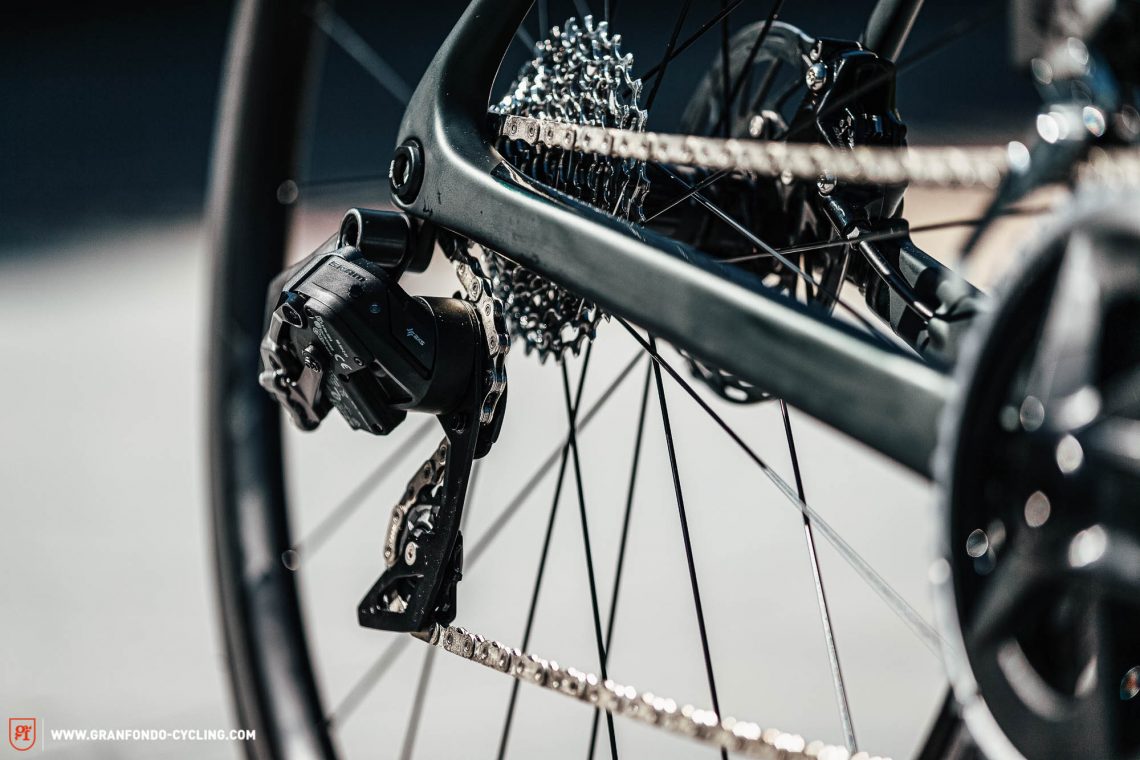
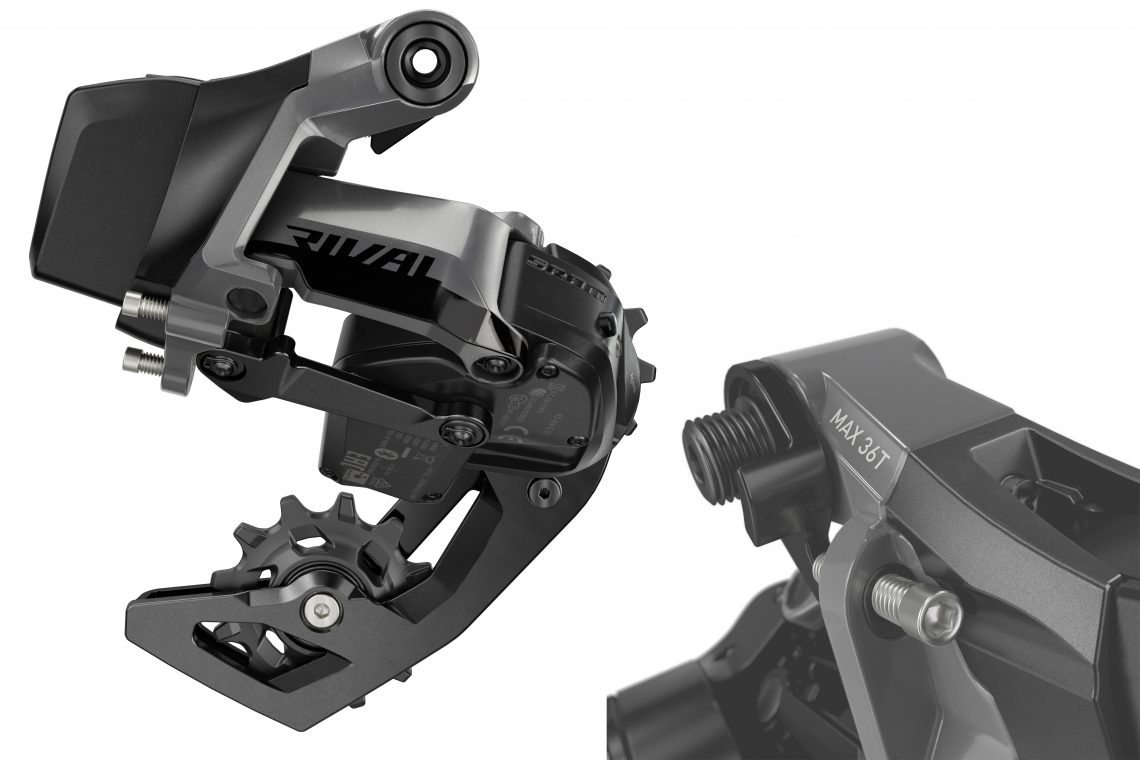
Herewith the weights and prices of SRAM Rival eTap AXS components compared to Force and RED eTap AXS
| Components | Model | Weight [g] | Price [€] |
|---|---|---|---|
| Cassette 10-36 t | Rival | 338 (+28 / +128)* | 125 |
| Force | 310 | 190 | |
| RED | 210 ** | 360 | |
| Crankset 175 mm 46/33 t | Rival | 844 (+103 / +284)* | 135 |
| Force | 741 | 250 | |
| RED | 560 | 700 | |
| Rear derailleur | Rival | 366 (+40 / +63)* | 265 |
| Force | 326 | 465 | |
| RED | 303 | 685 | |
| Front derailleur | Rival | 180 (+0 / +10)* | 180 |
| Force | 180 | 325 | |
| RED | 170 | 415 | |
| Shifter x2 | Rival | 845 (+23 / +109)* | 410 |
| Force | 822 | 660 | |
| RED | 736 | 1,200 | |
| Chain | Rival | 266 (+0 / +17)* | 31 |
| Force | 266 | 35 | |
| RED | 249 | 70 | |
| Total | Rival | 3,202 (+223 / +653)* | 1,411 (-314 / -2,169) |
| Force | 2,979 | 1,725 | |
| RED | 2,549 | 3,580 |
* Additional Weight compared to the Force and RED AXS groupsets
** Weight of the 10–33 t cassette, as 10–36 t isn’t available in the RED groupset
Our assessment of the new SRAM Rival eTap AXS groupset
It was only a matter of time before we’d see an affordable wireless groupset come to market – here it is! And with it, SRAM have also launched an all-new power meter. Coming in at less than € 1,500, the SRAM Rival eTap AXS is the logical next step in groupset evolution. Wireless shifting has long proven itself in the road and gravel bike sector and many riders will welcome the option of upgrading their bikes with SRAM’s latest offering. We’re curious to see when the new groupset will hit the shelves considering the stock shortages amid the current bike boom. We can’t wait to see what it’s capable of for ourselves!
For more information on the SRAM Rival eTap AXS groupset, visit sram.com
Did you enjoy this article? If so, we would be stoked if you decide to support us with a monthly contribution. By becoming a supporter of GRAN FONDO, you will help secure a sustainable future for high-quality cycling journalism. Click here to learn more.
Words: Photos: SRAM, Orbea, Philipp Schwab







